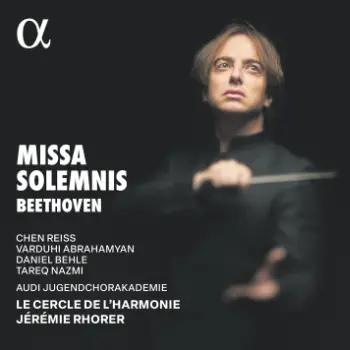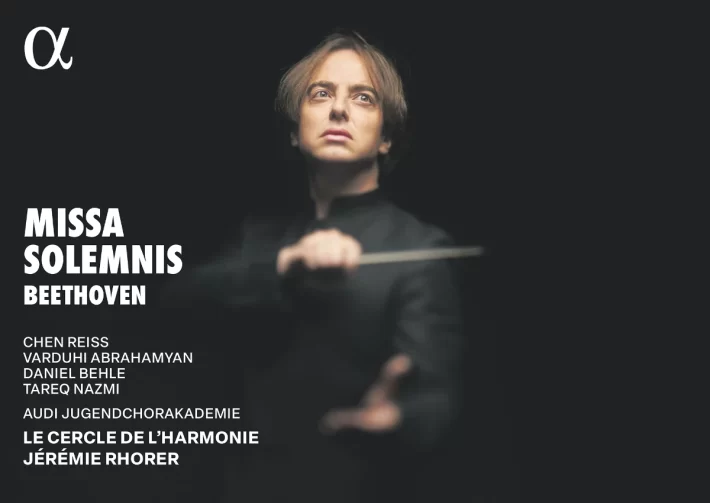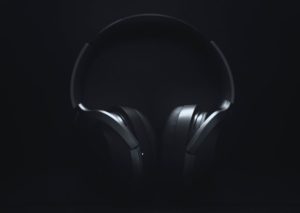Last January, in discussing Jordi Savall’s recording of Beethoven’s great mass, I spent a considerable portion of my review outlining interpretive changes brought about by historically informed performances (HIP). A meaningful change is speed: where the Klemperer, Bernstein and Karajan took 80+ minutes to perform the mass, HIP tend to hover around the 70-minute mark.

Check offers of this album on Amazon.
These faster performances have created a shift away from monumental conceptions to heightened drama and virtuosity. This new period instruments reading by Le Cercle de l’Harmonie under Jérémie Rhorer, is therefore directly competing with highly accomplished readings by Gardiner, Norrington, Herreweghe (Phi), and Jacobs (Harmonia Mundi).
Le Cercle de l’Harmonie is consistently impressive. Its string section, at least as recorded here, seems larger than many HIP recordings – the string ensemble has an admirable richness and depth. The forwardly balanced winds feature several characterful solos, though at times I found the horns too omnipresent in the overall balance.
Yet when the music is forte and above, there is a loss of clarity in the middle voices, and the timpani, which has crackling energy and presence in the Gardiner and Savall recordings, sounds muffled. The credits list this as a live recording made by Radio Classique in April 2024 at the Philharmonie de Paris, and I suspect a studio production would offer more sophisticated audio engineering.
The well-matched quartet dispatch their solos at a high standard, though the men strike as preferable to the women. Tenor Daniel Behleenor’s sweetly supple coloring often reminded me of Anthony Rolfe Johnson, and bass Tareq Nazmi’s is suitably stentorian. Soprano Chen Reiss is a little cool interpretatively, and mezzo-soprano Varduhi Abrahamyan develops a pronounced vibrato at forte and above. Nevertheless, their singing in the Sanctus-Benedictus is a high point of the performance, perhaps a reaction to the radiant, sweetly sung orchestral prelude.
I am hard pressed to list another youth choir that could tackle this notoriously demanding work. The Audi Jugendchorakademie has mastered the notes, rhythms, and Rhorer’s quick tempi (his speed for the Gloria’s “Quoniam” fugue is fast even by HIP standards). Diction (using Germanized Latin) is good, though it lacks the crisp, percussive attack of Gardiner’s Monteverdi Choir, or Harnoncourt’s Schoenberg Choir – this is apparent as early as the Christe section of the opening movement.
Choral balance is particularly problematic because Beethoven often has the sopranos singing in their highest register: there are several moments when tenors double the soprano at the octave where the sopranos dominate the texture. Considering that this is a live, one-off performance without patching sessions, the very few intonation issues are easily forgiven. And yet, it does not match the assured confidence and emotional intensity found in the Gardiner, Harnoncourt, and Savall recordings.
In those readings, the Gloria’s opening is a fervent explosion of joy, whereas here it feels cautious, as if the singers are carefully monitoring energy reserves to ensure they have what is needed to finish the movement (indeed, the entire piece).
Orchestra and soloists are impassioned in the Credo’s “Crucifixus,” making the most of its syncopated rhythms and szforzandis, yet the energy level lessens once the choir begins its interjections. And Rohrer’s hasty tempo for the “Et Resurrexit” pronouncement mutes the music’s startling emotional effect.
While the final portion of the Credo is not slow, it feels labored, or overly careful. The softer passages of the “Dona nobis” are sweetly sung, though the militant interruptions of brass and timpani can and should be more ferocious, and the choir is noticeably tired.
Despite excellent moments, this new reading does not displace the recordings discussed above. I would also urge readers to hear Glossa’s recording with Cappella Amsterdam and Orchestra of the Eighteenth Century led by Daniel Reuss. The orchestra’s softer grained sonority is like Le Cercle de l’Harmonie, but the quartet (led by Carolyn Sampson) and Cappella Amsterdam sing with greater passion and commitment, a recording that has never received the accolades it deserves.


Check offers of this album on Amazon.
Album Details |
|
|---|---|
| Album name | Beethoven – Missa Solemnis |
| Label | Alpha / Outhere |
| Catalogue No. | ALPHA1111 |
| Amazon Music link | Stream here |
| Apple Music link | Stream here |
| Artists | Chen Reiss, Varduhi Abrahamyan, Daniel Behle, Tareq Nazmi, Le Cercle de l’Harmonie, Audi Jugendchorakademie, Jérémie Rhorer |


















